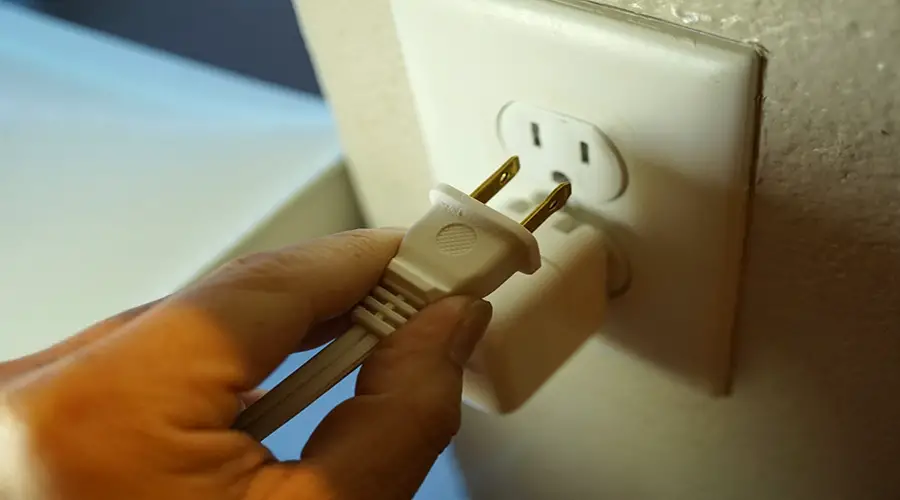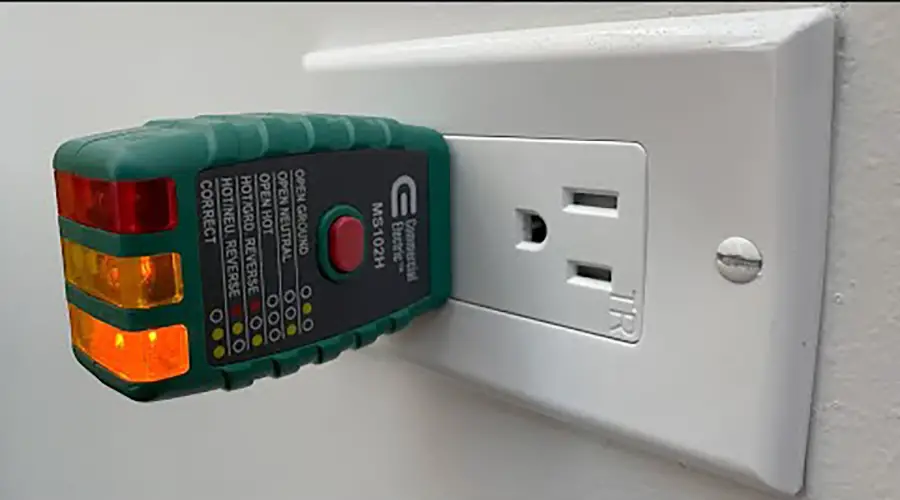
Tamper-resistant receptacles are identical to regular receptacles. But internal safety shutters block the two slots unless you insert the two prongs of a plug simultaneously. Tamper-resistant outlets prevent children from electrocuting themselves by sticking an item into a single slot.
Installing a plastic outlet cover is unnecessary if you have tamper-resistant outlets. Plastic receptacle covers plug into the outlet faceplate to prevent children from sticking foreign objects into a standard wall outlet.
The internal spring-loaded shutters do not open unless both plug prongs are evenly inserted into the outlet. They obstruct the electrical current flow until an electrical plug is inserted.
According to research conducted by Temple University, all 2- to 4-year-olds can remove one form of plastic outlet cap in ten seconds. This research concludes that there are 6 to 12 child fatalities each year due to this. (nfpa.org)
According to a ten-year study published by the U.S. Consumer Product Safety Commission, about 2,400 children are injured from electrical shocks each year in the home due to inserting foreign objects into unguarded electrical outlets. (nachi.org)
What Exactly are Tamper-Resistant (TR) Receptacles?
The face of a standard wall outlet typically has two plugs where you can plug in any compatible electrical device. These plugs typically have three holes, two small vertical slots across each other, and a large hole centered below.
The small opening on the left is the neutral slot and is typically slightly taller than its counterpart on the right, the hot slot. The ground hole is the larger centered opening below the neutral and hot slots.
Regular receptacle outlets have nothing blocking the neutral and hot slots. It can be dangerous because children often stick things into these holes and end up electrocuting or burning themselves.
The receptacles contain spring-loaded shutters that block improper access to the hot and neutral metal prongs. This prevents the insertion of items like paper clips into live contact openings.
Tamper-resistant receptacles are an important safety measure required by code in childcare facilities, schools, and businesses accessible to children.
Tamper-resistant outlets work to overcome this safety issue by having a cover inside the outlet that protects the neutral and hot slots. The shutters act as a barrier blocking contact openings for foreign objects, allowing electricity to flow only when two prongs are inserted together.
The only way to remove the cover is by plugging in a device and applying pressure with the two prongs in both slots. The covers will retract and allow you to plug in like a regular receptacle.
TR receptacles look and behave precisely like regular open outlets, but they have a crucial safety feature that saves lives.
How to Tell If an Outlet is Childproof?
The benefits of tamper-resistant receptacles are apparent, but many people wonder if the outlets in their homes are childproof. The only difference between the two receptacles is the inner cover over the plug-in slots.

Method 1: Look for TR on the Receptacle
The easiest way to identify a tamper-resistant receptacle is to look for a capital TR embossed on the receptacle. Notice the TR embossed on the receptacle in the photo above. The NEC 2020 code revisions explicitly require TR receptacles.
Method 2: Look for the Outlet Slot Covers
The second easiest way to identify TR electrical outlets is to look for the inner slot covers. Sit about six inches away from the outlet at eye level and look into the two upper slots of the receptacle (the neutral and hot slots).
- If the two openings seem to extend far into the outlet and fall away into shadows, your outlet is likely a regular receptacle.
- If the two openings abruptly stop about 1⁄4 of an inch in by a white cover, your outlet is likely tamper-resistant.
- If one of the openings abruptly stops at a white cover and the other seems to extend farther, your outlet is likely tamper-proof. Since only one of the slots has a cover, it is broken, and you should replace the receptacle.
Method 3: Plug Something Into the Outlet
Find an electrical device in your home that plugs into a wall outlet to test whether your plug has tamper protection.
Plug the electrical device into the outlet while paying particular attention to any resistance you feel when plugging it in.
- If you plug the device in and there is zero resistance when you push the two prongs into the outlet, your outlet is likely a standard wall outlet.
- If you plug the device into the outlet and there is resistance, but it quickly releases and allows you to plug it in all the way, it’s likely a tamper-resistant outlet. The receptacle’s safety shutters temporarily impede plug insertion until simultaneous contact is made with both prongs to complete the electrical circuit.

Where Should You Use Tamper Proof Outlets?
The National Electric Code (NEC) now requires all outlets to be tamper-resistant. Any time you install a new wall receptacle, ensure it is a tamper-resistant outlet. Not only does this keep your home up to electrical code, but it is also much safer.
Tamper-resistant receptacles are mandatory in residential buildings and accessory structures like garages and sheds per NEC 2020 rules. They help prevent electrical injuries from curious children probing outlets.
You can leave existing regular outlets as-is, but you must use tamper-resistant receptacles once you need to replace them due to old age or any other reason. Even if they still work, it is best practice to go through your home and replace any regular open outlets with new ones to prevent accidental electric shocks.
When replacing old receptacles, always choose UL-listed tamper-resistant receptacles that meet the latest NEC codes for residential and commercial buildings.
If your home has ungrounded 2-prong outlets, they’re certainly not childproof. If you live in an old house with no electrical renovations within the last ten years, you can be confident the outlets don’t resist tampering.
How to Use a Tamper-Resistant Receptacle
You can use a tamper-resistant receptacle precisely like you would a regular outlet. You might feel a little resistance when plugging in a device, but the internal shutters will give way if you push the plug in evenly.
Stop pushing if you attempt to plug an electrical device into a tamper-resistant outlet, and it is incredibly challenging. Pushing too hard can break the receptacle. The shutters prevent a single prong or object like a paperclip from accessing the energized contacts.
If you cannot seem to get something to plug it, there are two possible problems: the prongs are not straight, or you’re not applying equal pressure to both prongs.
Use a pair of pliers or your hands to straighten the plug’s prongs carefully. Then try again, ensuring you apply equal pressure to both prongs so they enter the outlet simultaneously.
Tamper Resistant Outlets FAQs
In what locations are tamper-resistant receptacles not required?
The National Electrical Code requires tamper-resistant receptacles for all new outlet installations and outlet replacements, regardless of location. There are no exemptions specified for certain locations.
Why are tamper proof outlets so hard to use?
The internal shutters that block the slots for safety can take extra force to push open when plugging in a device. If the prongs are not aligned properly, or equal pressure is not applied to both prongs simultaneously, the shutters will not open easily.
Do I have to replace outlets with tamper-resistant ones?
You don’t need to replace working standard outlets proactively. However, the National Electrical Code mandates installing a tamper-resistant receptacle when an outlet requires replacement. Over time, all outlets will transition to TR outlets.
Do tamper-resistant outlets wear out faster?
No, tamper-resistant outlets are just as durable as regular outlets. The internal shutters don’t affect lifespan.
Are TR outlets more expensive?
TR outlets cost a few cents more than regular outlets, a negligible price difference.
Can I install tamper-resistant outlets myself?
Yes, tamper-resistant outlets can be installed safely by a homeowner, like any other outlet, as long as proper precautions are taken.
Do tamper-resistant outlets look different?
Tamper-resistant outlets look almost identical to regular outlets. Look for a “TR” marking or internal shutters to identify them.
Are tamper-resistant outlets required in bathrooms?
Yes, tamper-resistant outlets are required in all locations for new installations and replacements per NEC code. For wet areas, tamper-resistant GFI outlets are available.
Final Thoughts
A licensed electrician can help you replace standard receptacles with tamper-resistant ones. You can expect replacement will cost $20 to $30 per outlet.
Tamper-resistant receptacles are available in various styles and colors to match any decor while providing an essential safety measure for children.







